Scratch ASP-1 Original Design / Scratch Built
Scratch - ASP-1 {Scratch}
Contributed by William Beggs
| Manufacturer: | Scratch |

Brief:
My upscale project is the ASP sounding rocket. Modeled after the Model Products Corporation (MPC) ASP-1, which has a
body diameter of 0.591" and is offered by FlisKits. My project has a diameter of 1.315" which makes it a
2.225 upscale version of the MPC kit. My version is approximately 1/5 scale of the original.
The scale of this project, like most of my projects, was based on what I had laying around. I found that I had an Estes BT-55 Ogive nosecone, some Estes BT-55 body tube and some 1/8" balsa. I also found some 24mm motor tube, some BT-55 to 24mm centering rings, a BT-55 tube coupler, elastic recovery strap, and an Estes 24" plastic parachute.
The first thing I did was get the original dimensions from the book Rockets of the World by Peter Alway. I also referred to a detailed drawing that I purchased a copy of from the Smithsonian National Air and Space Museum that G. Harry Stine made back in 1968 of the ASP. After getting all of the necessary dimensions, I entered them into a drawing program that I have called, FASTCAD. Once the basic structure was laid out, I then scaled down the drawing so that the outside body dimension was 1.315 inches or the same as the Estes body tube that I was going to use.
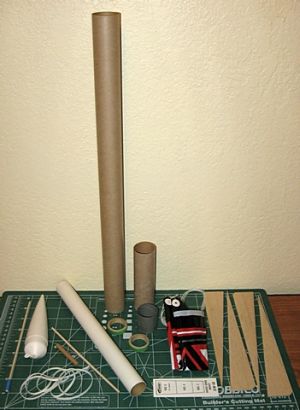 I then took all of the dimensions and entered them in to the RockSim software from Apogee Components to
calculate the center of pressure. From this I was also able to figure about how much weight I was going to need to add
to the nose cone to ensure a stable flight. I based the additional nose weight on the largest motor that I planned to
use which was an Estes 24mm E. The additional nose weight came out to about 25 grams.
I then took all of the dimensions and entered them in to the RockSim software from Apogee Components to
calculate the center of pressure. From this I was also able to figure about how much weight I was going to need to add
to the nose cone to ensure a stable flight. I based the additional nose weight on the largest motor that I planned to
use which was an Estes 24mm E. The additional nose weight came out to about 25 grams.
Construction:
I first printed out a 1:1 scale fin template from my FASTCAD software and used it to mark the 1/8" thick balsa
sheet that I had. I then used a #11 X-Acto blade to cut the fins out. Since the fins stick down past the end of the
body tube, I decided that they needed to be a little stronger so I decided to use one layer of carbon fiber. This adds
a lot of time as well as a little bit of expense to the project but will make a much better vehicle and should last a
lot longer.
After finishing all four fins I proceeded to assemble the motor tube. I used a 10" long piece of 24mm motor tube along with two ¼" thick Estes centering rings.
I then used an Estes fin marking guide to mark where the fins were to be placed and used an angled ruler to draw the lines straight down the body tube.
Once this motor tube assembly was dry I epoxied the inside of the body tube and inserted the motor tube assembly such that it was flush with the bottom of the body tube.
 After the motor tube assembly was secure I proceeded to attach the fins. I used a thin layer of two-part
5-minute epoxy to attach each fin. I also used the Estes fin alignment tool to make sure that each fin was
perpendicular and properly aligned with the body tube.
After the motor tube assembly was secure I proceeded to attach the fins. I used a thin layer of two-part
5-minute epoxy to attach each fin. I also used the Estes fin alignment tool to make sure that each fin was
perpendicular and properly aligned with the body tube.
Once all of the fins were attached to the body tube I then proceeded to add a fillet of two-part 5-minute epoxy to each of the fin roots to give it some more strength as well as make the attachment look clean. Now I just need to add the detailed flare extensions to the fins and they will be all done.
Next I attached the recovery system. The recovery system is made up of a one foot long piece of Estes elastic shock cord and one two foot long piece of ¼" wide Kevlar® strap. I used the traditional Estes attachment by using an Estes cardboard cutout and gluing it to the inside of the body tube about two inches down from the top.
I then tied the elastic and Kevlar® together. Next, I tied the elastic to the molded loop on the nose cone.
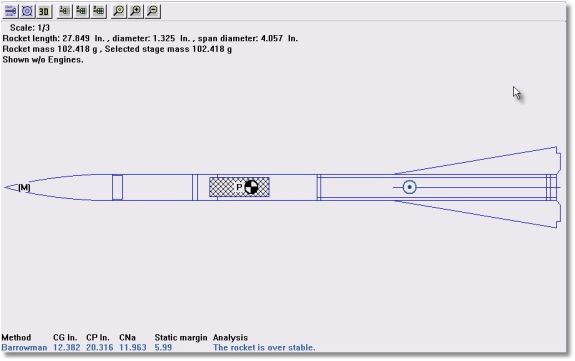
Finishing:
For the paint scheme I have decided to use the one from "Operation REDWING Bikini Flights" that G. Harry
Stine made drawings of back in 1968 which I was able to get copies of from the Smithsonian National Air and Space
Museum archives. The special thing about the Bikini Flights is that the ASP was used to take measurements inside and
above the mushroom clouds created by nuclear explosions. When a nuclear device was detonated, a battery of ASPs would
be launched into and above the clouds and would transmit back their readings.
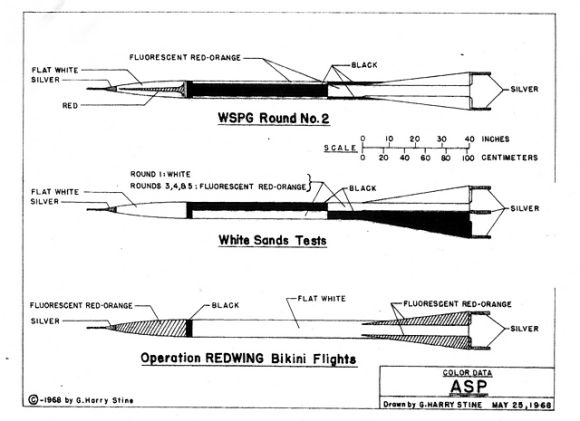
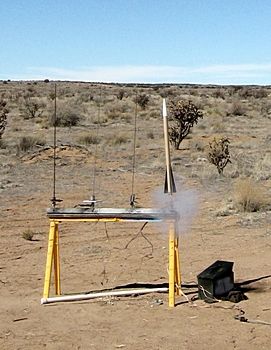
Flight:
The first flight was on a C11-3. The rocket flew great and deployed the parachute right at apogee. The weather was
great with the temperature in the high 40s to low 50s and clear blue sky.
The second flight was on a D12-5. Once again it was a perfect flight and recovery with the parachute coming out at apogee. This rocket really flies well and really zips off the pad.
The third flight was on an Estes E9-6. This flight was also good but the recovery was a little early. Even with the early deployment there was no damage. I'm estimating that it did nearly 1000 feet and was really up there. It ended up coming down about a quarter mile away since there was a breeze of about 5 mph. Now it's off to paint.
Recovery:
Every flight has had a flawless recovery and I've only been using 5 pieces of Estes wadding to make sure that he
parachute doesn't get burned.
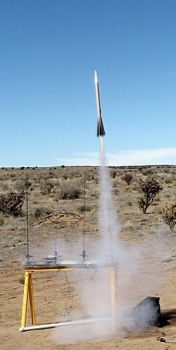
Summary:
This has been a fun rocket to design, build, and fly. It took very little to put it together except for the carbon
fiber on the fins, and it flies extremely well. Many people have commented on the carbon fiber fins but the next time I
fly it, it will have fluorescent orange on them. Maybe, I'll see what it will do on an F motor.
Overall PROs:
- Classic aerodynamic design (This rocket looks fast)
- Flies straight and on a E motor will really get up there
- Cheap to build (Non-carbon fins)
- Cheap to fly on since it handles a variety of 24mm motors
- Reliable recovery with Kevlar® and elastic
Overall CONs:
- No motor retention
- Small external parts will get lost and broken over time
- A little pricey and time consuming if adding carbon fiber to the fins
 |
 |